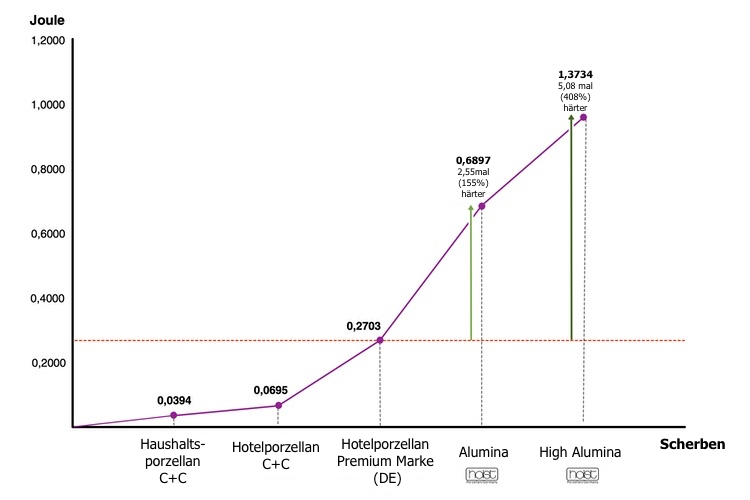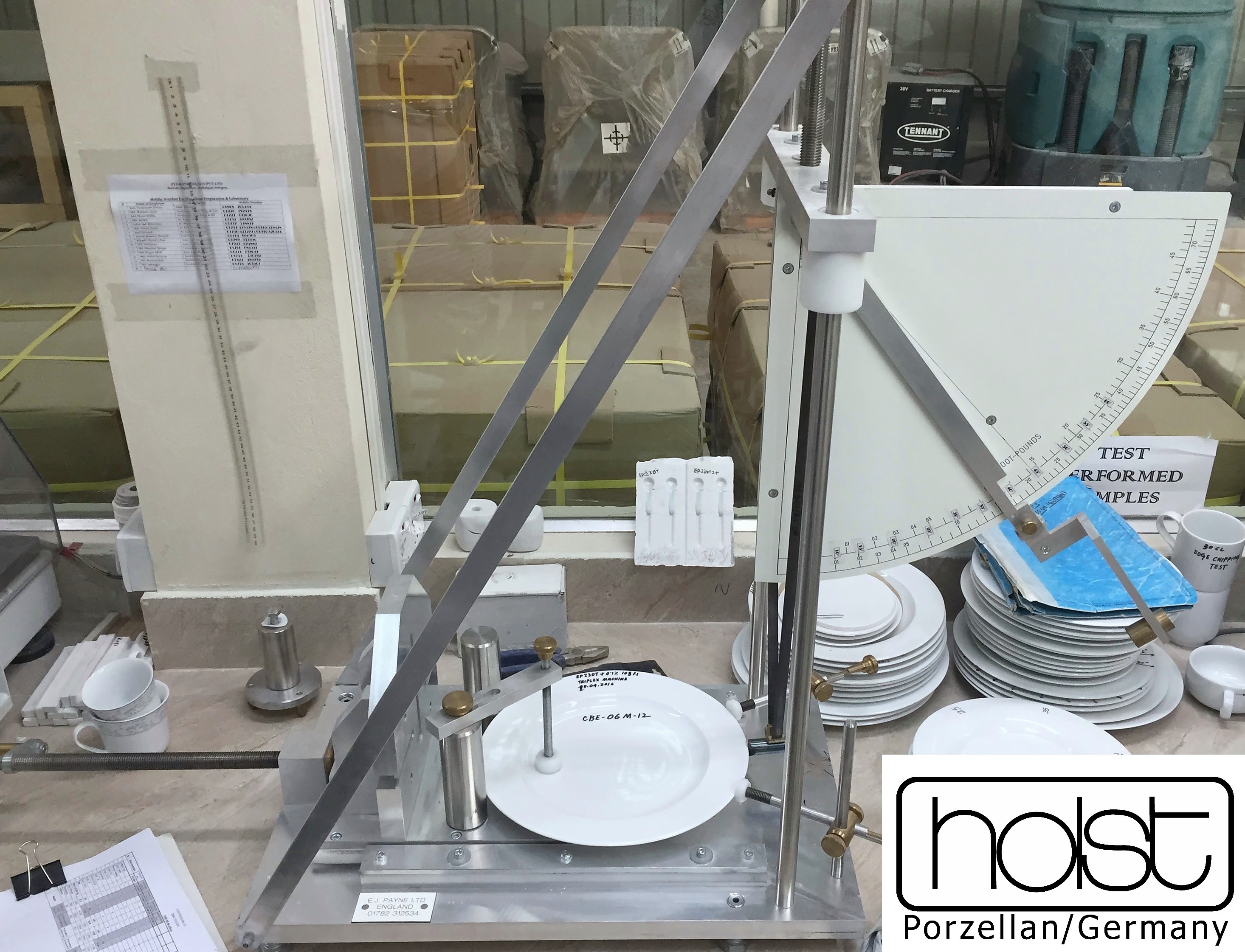Edge impact resistance
Edge impact resistance of the different types of porcelain
In the case of porcelain and ceramic products, an edge impact test serves to show the physical resistance to mechanical impact in a readable and comprehensible unit. Since the "edge" represents the external finish of an article, the resistance of the respective piece of tableware to mechanical impact is measured at the most sensitive point. The edge impact test thus provides information about the durability and stability of the tested cullet (the name for the fired porcelain mass) and the glaze (which is applied to protect the cullet). As a result, an impact test covers both the glaze and the body.
We porcelain makers measure the physical resistance of our goods in "edge impact strength"!
In physics (mechanics), impact refers to an energetic impulse effect (force impact) in which two or more bodies briefly exert force on each other. The supply of energy is necessary to accelerate a body. Thus, energy is a fundamental quantity for the force effect (measurement) of impact or shock. The consequence of an impact is the change in the state of motion of a body, possibly also the change in its shape or composition. A distinction is made between
- a straight, central, elastic impact
- a transverse elastic impact
- an eccentric impact
- a rough impact
If you look up the English name of this measuring method - Impact Hammer Test - it is easy to see that it is an extremely complicated process that is influenced by a number of different components.
- Length of the pendulum
- Weight of the hammer
- Shape of impact hammer and contact point
- Room temperature
- Temperature of the testing object
During an extensive series of tests in September 2019, we had the officially approved testing device of the English manufacturer EJ Payne Ltd., model number 312534 with its 3 scales explained to us in detail. On the device you can read: Food Pounds, Pounds and Angle. The laboratory technician in turn determines the exact resistance in the unit joule from the impact test with these three values, the length and weight of the pendulum. From the edge impact test with an angle of 30°, our technician calculates the resistance of 0.7491 Joule. We wanted to know exactly and asked:

The 190 gram impact hammer strikes the plate on a 0.62 meter long pendulum with a drop angle of 30°. You hear a bright, loud bang and understand that "this is pretty firm". With the unit joule, however, it is difficult (probably not only for us) to understand, estimate and transfer this striking power to an imaginable size. Therefore, we try another - tangible - method to understand the power of impact. We hold our flat palm to the measuring point and drop the hammer again at 30°. We hereby assure that already 30° drop angle causes a quite respectable pain and prevents the test person from increasing the striking angle or from further tests. In other words, a 30° angle of fall of a 190 gram hammer corresponds to a good slap in the face.
Result series of chipping tests
Our test series in September 2019 did not only include our own qualities from Holst Porzellan. To obtain a comprehensive market overview, we tested many well-known brands, private labels and types of tableware under the same conditions as our own collection. We wanted to know how good Holst Porzellan is compared to other brands and qualities. In total, we dropped the hammer of our test machine on 90 different items. In order to make the test series "waterproof" or unassailable, we carried out the results in two different laboratories with two different test machines of different makes, in compliance with the standard "BS EN 12980" and with the help of the testing institutes "Bureau Veritas" and "Lucideon".
- Only porcelain qualities of the same kind were tested /hard firing > 1.300 °C
- Flat parts (plates) of the same size were tested
- Each test series is internally documented with a video
- Each test sample has received a test certificate
In order to ultimately compare values for the edge impact strength of different types of tableware that are readable and understandable to the layperson, a comparison of the determined Joule values is sufficient if they are compared with each other in percentage terms. This seems to us to be the best method for understanding the stability of tableware pieces measured in Joules.
The most important laboratory results
| Body thickness | Description | Brand | Execution | Joule | Deviation (*) |
| Household | Feldspar Porcelain | C. + C. (RU) | Standard | 0,0394 | out of evaluation |
| Hotel | Feldspar Porcelain | C. + C. (TR) | Semi-strong | 0,0695 | Messpunkt |
| Household | High Alumina Porcelain | Holst Porzellan | Standard | 0,0721 | 3,7% |
| Hotel | Feldspar Porcelain | Hotelmarke (DE) | Halbstark/Randverstärkt | 0,0821 | 18,1% |
| Hotel | Feldspar Porcelain | Versender (BD) | Halbstark/Randverstärkt | 0,1083 | 55,8% |
| Hotel | Feldspar Porcelain | Versender (CN) | Halbstark/Randverstärkt | 0,1083 | 55,8% |
| Haushalt | Alumina Porcelain | Holst Porzellan | Semi-strong | 0,1287 | 85,1% |
| Hotel | Feldspar Porcelain | Lubiana (PL) | Semi-strong | 0,1547 | 122,6% |
| Hotel | Feldspar Porcelain | Versender (CN) | Massive | 0,1547 | 122,6% |
| Hotel | Feldspar Porcelain | Premium brand (DE) | Semi-strong/edge reinforced | 0,2703 | 288,9% |
| Hotel | Alumina Porcelain | Holst Porzellan | Semi-strong/edge reinforced | 0,6867 | 888,1% |
| Hotel | High Alumina Porcelain | Holst Porzellan | Semi-strong/edge reinforced | 0,7603 | 994,0% |
| Hotel | High Alumina Porcelain | Holst Porzellan | Semi-strong/edge reinforced | 0,8565 | 1132,4% |
| Hotel | High Alumina Porcelain | Holst Porzellan | Semi-strong/edge reinforced | 0,9549 | 1274,0% |
| Hotel | High Alumina Porcelain (2. Gen) | Holst Porzellan | Semi-strong/edge reinforced | 1,3734 | 1876,1% |
(*) The deviation describes the percentage "harder than" a standard hotel porcelain from a well-known German C+C specialty store chain of Turkish manufacture.
The most important conclusions

Guarantees - expectations and market response
Holst Porzellan especially praises the quality and especially the durability of "High Alumina Porcelain" in the combination of "physical resistance" and "hardness". Occasionally we are asked by dealers and commercial end users why we do not give an "edge-beating guarantee" on our porcelain, as other porcelain brands do (status 7/2017).
Now Holst Porzellan is since 1928 on the market and is concerned since 1955 with the topic "hotel porcelain". At the beginning of the 2000s, the European Union succeeded in prescribing a number of properties and requirements for porcelain as a material, so that tableware was declared a foodstuff commodity virtually from a vacuum. In particular, the various laws and standards ensure that no harmful substances from the material are transferred to food. This is also a good thing!
But an edge chipping guarantee? If you throw dishes on the floor, use them in a relationship dispute or treat them roughly in any other way... they will break! Yes, ceramics and porcelain can be made more "stable" by special processing techniques, but that doesn't make them unbreakable!
Term Analysis Edge Impact Guarantee
In order to better understand the term "Kantenschlaggarantie", we will first analyze the word according to its three components.
Edge refers to the outer edge or corner of a surface or object. Edge in general refers to a line where two different surfaces meet. Thus, the edge is a part of the body (the name of the fired porcelain mass) and the glaze (applied to protect the body). It follows that the warranty covers the glaze and body.
In physics (mechanics), impact refers to an energetic impulse effect (force impact) in which two or more bodies briefly exert force on each other. The supply of energy is necessary to accelerate a body and is therefore a fundamental quantity for the force effect (measurement) of impact or shock. The consequence of an impact is the change in the state of motion of a body, possibly also the change in its shape or composition. A distinction is made between
- a straight, central, elastic impact
- a transverse elastic impact
- an eccentric impact
- a rough impact
Guarantee means the legally binding promise of a legal entity about a certain characteristic, a certain action or omission even before the occurrence of a certain event. In the event of functional defects during a warranty period, the manufacturer or seller who has given the warranty undertakes to restore the functional capability free of charge. The conditions of the guarantee are set out in a guarantee certificate. The use of language often makes no difference between the legal warranty obligation and an additional contractual guarantee offered voluntarily, whereas - from a legal point of view - these are different rights or obligations.
Conclusion - Edge chipping guarantees for tableware translated
The manufacturers of porcelain or other ceramic tableware give a durability guarantee for the edge of a tableware piece (usually flat pieces) against a mechanical impact impulse with their edge impact guarantee. Usually the guarantee is limited in time and is indicated with different periods of time. This guarantee thus consists of three sizes:
- Definition of the product
- Time limit
- Description of the load limit
From the guarantee conditions for edge chipping of other brands
With this knowledge we read the warranty conditions of some tableware suppliers and analyze their business practices. We have marked the prominent positions in bold for you.
Villeroy & Boch: "... as ...a German company Villeroy & Boch AG is therefore able to give a warranty on edge impact resistance for table-ware series...the warranty covers plates, saucers, flat and deep plates of the Hotel & Restaurant series of "Premium Porcelain"... The warranty is only valid for new products of first choice from the date of invoice and is only valid upon presentation of the original invoice document. The guarantee applies to the edge chipping that occurs during normal use...Any edge chipping caused by unusual, unusual or improper use, as well as breakage of the body or parts of the body, are expressly excluded from this warranty..."
Vega-Direct: "... The guarantee applies to the edge chipping, which occured under despite of professional handling and normal use. and normal use. Edge chipping caused by improper handling, ... Breakage or parts of the broken body are excluded from this warranty..."
Nisbets: "... The edge chipping guarantee is only valid for normal use such as refrigeration, serving, washing up and storage in accordance with the Nisbets terms of use. There is no warranty claim for damage, improper use or other breakage damage. The buyer pays the costs of transport to Nisbets. The buyer pays the costs of transport to Nisbets."
Churchill: "... To be eligible for the Churchill 5 year Edge Chip Policy the attached registration document must be returned within 60 days from the date of the original invoiced order. Terms and Conditions apply.... This warranty covers edge chipping only (not breakages)... “in normal food service use,” which includes refrigeration, serving, washing and storage. The warranty does not extend to other types of breakage and the validity of the warranty claim is at the sole discretion of Churchill."
RAK Porcelain: "...To use this service, you must register the form with the proof of purchase (invoice) within 30 days of receipt of the goods, otherwise we cannot accept the warranty claim.... This warranty only covers damage occured despited of proper use. The warranty does not cover breakage or damage due to improper use of our products..."
The validity of these warranty conditions
In ignorance of the goodwill of these tableware suppliers, which possibly exceeds these warranty conditions - be it for reasons of prestige or the desire to maintain advertising effectiveness - we summarize the tangible legal status of these warranty conditions for you.
- All guarantee conditions are missing the specification "energy" in the definition of impact
- Alternatively, all suppliers use the definition "normal use" or "intended use"
- Each of these suppliers - as well as Holst Porzellan - can clearly prove the edge impact strength of their tableware in physical units of measurement (mostly in joules)
- Usually - with probably all brands of hotel porcelain known to us - "normal use" always falls below the load limits of the tableware.
- Restrictions such as "applies like refrigeration, serving, washing up and storage" underline clauses that make it easier to get out of the warranty
- Clauses such as "you must register with us" are customer catching - and certainly difficult to reconcile with the Data Protection Act
- If you smash an "edge" into the "edge" of a piece of crockery, the shard and glaze will have broken. Breakage is expressly excluded with all the above-mentioned suppliers
- If guarantees only apply to first choice products, it should be noted that in the hotel porcelain segment, mixed assortments are sold predominantly
- Not one of the above-mentioned suppliers guarantees the hardness of its tableware
Since we do not wish to enter into any competition law dispute with the presentation of this topic, we refrain from assessing the value of edgefolding guarantees and leave it to the reader to draw his own conclusions.
Holst Porzellan guarantees our high-alumina porcelain - for a lifetime - an edge impact strength of 0.6080 joules and proves this with a corresponding test video. Above all, our high-alumina porcelain combines extreme edge impact resistance with the hardness of fired feldspar porcelain..
The videos of the test series Edge chipping
Holst Porzellan (high-alumina hotel porcelain with reinforced edges) ---> Test 75° passed!
Hard Stoneware Portugal (household quality) ---> Test 40° not passed!
Porcelain Poland (hotel porcelain without edge reinforcement) ---> Test 40° not passed!
Porzellan China (hotel porcelain without edge reinforcement) ---> Test 40° not passed!
Premium porcelain (hotel porcelain with reinforced edges) ---> Test passed 40°!
Porcelain Poland (hotel porcelain with edge reinforcement) ---> Test 40° not passed!
Porzellan Bangladesh (household porcelain without edge reinforcement) ---> Test 40° not passed!

